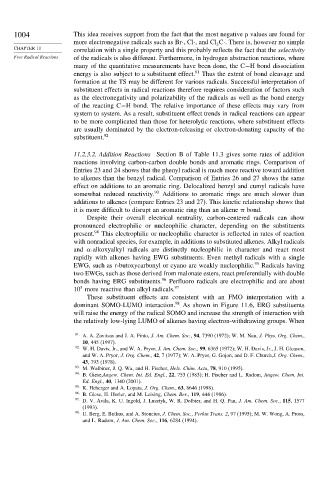Page 1020 - Advanced Organic Chemistry Part A - Structure and Mechanisms, 5th ed (2007) - Carey _ Sundberg
P. 1020
1004 This idea receives support from the fact that the most negative values are found for
more electronegative radicals such as Br·,Cl·, and Cl C·. There is, however no simple
3
CHAPTER 11 correlation with a single property and this probably reflects the fact that the selectivity
Free Radical Reactions of the radicals is also different. Furthermore, in hydrogen abstraction reactions, where
many of the quantitative measurements have been done, the C−H bond dissociation
energy is also subject to a substituent effect. 91 Thus the extent of bond cleavage and
formation at the TS may be different for various radicals. Successful interpretation of
substituent effects in radical reactions therefore requires consideration of factors such
as the electronegativity and polarizability of the radicals as well as the bond energy
of the reacting C−H bond. The relative importance of these effects may vary from
system to system. As a result, substituent effect trends in radical reactions can appear
to be more complicated than those for heterolytic reactions, where substituent effects
are usually dominated by the electron-releasing or electron-donating capacity of the
substituent. 92
11.2.3.2. Addition Reactions Section B of Table 11.3 gives some rates of addition
reactions involving carbon-carbon double bonds and aromatic rings. Comparison of
Entries 23 and 24 shows that the phenyl radical is much more reactive toward addition
to alkenes than the benzyl radical. Comparison of Entries 26 and 27 shows the same
effect on additions to an aromatic ring. Delocalized benzyl and cumyl radicals have
somewhat reduced reactivity. 93 Additions to aromatic rings are much slower than
additions to alkenes (compare Entries 23 and 27). This kinetic relationship shows that
it is more difficult to disrupt an aromatic ring than an alkene bond.
Despite their overall electrical neutrality, carbon-centered radicals can show
pronounced electrophilic or nucleophilic character, depending on the substituents
present. 94 This electrophilic or nucleophilic character is reflected in rates of reaction
with nonradical species, for example, in additions to substituted alkenes. Alkyl radicals
and -alkoxyalkyl radicals are distinctly nucleophilic in character and react most
rapidly with alkenes having EWG substituents. Even methyl radicals with a single
EWG, such as t-butoxycarbonyl or cyano are weakly nucleophilic. 95 Radicals having
two EWGs, such as those derived from malonate esters, react preferentially with double
bonds having ERG substituents. 96 Perfluoro radicals are electrophilic and are about
3
10 more reactive than alkyl radicals. 97
These substituent effects are consistent with an FMO interpretation with a
dominant SOMO-LUMO interaction. 98 As shown in Figure 11.6, ERG substituents
will raise the energy of the radical SOMO and increase the strength of interaction with
the relatively low-lying LUMO of alkenes having electron-withdrawing groups. When
91
A. A. Zavitsas and J. A. Pinto, J. Am. Chem. Soc., 94, 7390 (1972); W. M. Nau, J. Phys. Org. Chem.,
10, 445 (1997).
92 W. H. Davis, Jr., and W. A. Pryor, J. Am. Chem. Soc., 99, 6365 (1972); W. H. Davis, Jr., J. H. Gleason,
and W. A. Pryor, J. Org. Chem., 42, 7 (1977); W. A. Pryor, G. Gojon, and D. F. Church,J. Org. Chem.,
43, 793 (1978).
93
M. Walbiner, J. Q. Wu, and H. Fischer, Helv. Chim. Acta, 78, 910 (1995).
94 B. Giese,Angew. Chem. Int. Ed. Engl., 22, 753 (1983); H. Fischer and L. Radom, Angew. Chem. Int.
Ed. Engl., 40, 1340 (2001).
95
K. Heberger and A. Lopata, J. Org. Chem., 63, 8646 (1998).
96
B. Giese, H. Horler, and M. Leising, Chem. Ber., 119, 444 (1986).
97 D. V. Avila, K. U. Ingold, J. Lusztyk, W. R. Dolbier, and H. Q. Pan, J. Am. Chem. Soc., 115, 1577
(1993).
98
U. Berg, E. Butkus, and A. Stoncius, J. Chem. Soc., Perkin Trans. 2, 97 (1995); M. W. Wong, A. Pross,
and L. Radom, J. Am. Chem. Soc., 116, 6284 (1994).

